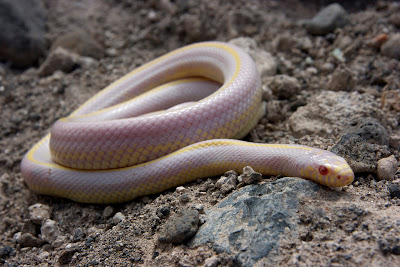. |
| California kingsnake (striped albino pattern). Photo © Ramón Gallo Barneto |
Snakes are often introduced also as cargo stowaway. In this way many species manage to colonise even remote oceanic islands, where they can represent a serious threat to some of the most and unique living creatures of the world. A renowned case of accidental introduction concerns the brown tree snake (Boiga irregularis). Soon after World War II this native of the Solomon islands, northern Australia and Papua New Guinea, was transported as stowaway by military cargos to the island of Guam, Mariana Islands. In this western Pacific island this ecologically disrupting predator is having a dramatic ecological and economic impact. In particular is negatively affecting several species beside having killed off at least 8 of the island’s 11 species of native birds, as well as some indigenous lizards and bats. Now there is a growing concern that the species could take advantage of the frequent aircraft flights from Guam to the Hawaii and make its way to this archipelago in central Pacific, where its ecological and economic impact would be even greater (according to some studies it might cost over 1.7 billion dollar per year if successfully introduced).
 |
| Brown Tree Snake. Photo © Daniel O'Brien |
Accidental introductions linked to military activities are likely to have occurred also in ancient times: perhaps snakes were used to frighten enemies even during Roman assaults. As suggested for the origin of the viperine snake (Natrix maura) in the Balearic, Spain, some introduced populations of snakes in the Mediterranean islands could be actually linked to such battle related events. Also this snake is having a major ecological impact in terms of loss of indigenous species, and changes in community structures and function. In fact in the Balearic Islands, the introduced viperine snake is known to represent a serious threat for the endangered endemic Mallorcan midwife toad or ferreret (Alytes muletensis) in Mallorca, and was probably involved in the extinction of the species in Menorca.
Other than inflicting ecological harm, non-indigenous snakes can be dangerous to humans, as some species are also poisonous. A typical poisonous snake introduced outside its natural range is the habu (Trimeresurus flavoviridis), a Japanese native viperid introduced in Minnajima, Okinawa Island. Also the brown tree snakes is well known for its venomous bites: in Guam the estimated cost for hospitalisation and intensive care for people affected by snakebite (especially infants) is about 25,000 dollars per year. Along with the ecological damages and the health problems, the brown tree snake can also provoke significant economic impacts, like frequent power outages and damage to the electric lines due to the attitude to crawl along the wires: yearly cost for direct damages and lost productivity is conservatively estimated at 1 million dollars.
Thus, nothing to do with the notorious old rumor, still very popular in countries like Italy, according to which snakes, and particularly vipers, are recurringly broadcasted by helicopters - by either environmentalists or parks authorities - to restore their wild populations. Here the problem for nature conservation professionals is how to prevent the further release or spread of snakes and other harmful alien species outside their natural range, where they clearly represent a key driver of biodiversity loss.
